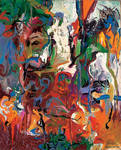Amaranth Ehrenhalt – A Hidden Treasure
October 22, 2011 – January 31, 2012
Amaranth Ehrenhalt’s colorful and dynamic Abstract Expressionist style, manifested over decades in various mediums, will be on display at the Anita Shapolsky Gallery–October 22nd through January 2012. Born in Newark, New Jersey and educated at the Pennsylvania Academy of the Fine Arts in Philadelphia, Ehrenhalt’s career has spanned decades of art movements. Her adventurous spirit led her to Paris where she met and exhibited with several expatriate artists of the abstract New York School, including Sam Francis, Joan Mitchell and Shirley Jaffe. On the eve of her departure for Paris, Ehrenhalt met de Kooning for a drink at the legendary Cedar Tavern; the dinner they planned upon her return never happened, as it wasn’t until 2008 that she came back to New York permanently.
Lyrical, intuitive and generous in her creative process, Ehrenhalt lives and thinks her art. Known for her spontaneous style, her work retains parallels to the automotive modes of the surrealists.1
The use of vibrant and warm colors in works such as “Jump In and Move Around” from 1962 has also invited comparisons to the ‘sensual colorist traditions’ of the European modernists.2 Joseph Hirshhorn described Ehrenhalt as developing ‘her own language,’ while her lingering interest in organically drawn lines has at times insinuated “a new, possibly eerie, form of figuration.”3 Though her work has transformed over the years, it maintains the lush colors, bustling compositions and variegated layers of depth characteristic of her style. Ehrenhalt’s adept straddling of many influences, from Paris-based Abstract Expressionism to early Modernism via her education at the Barnes Foundation (Cezanne, Renoir, Matisse), imbues her work with palpable energy and excitement.
Ehrenhalt displays the self-reflexivity common to the second generation of American abstract artists. Listed among her early influences are El Greco, Giotto, Cimabue, Kandinsky and Jackson Pollock, artists who impacted her aesthetic. In this regard, she embodies a common sentiment felt by her contemporaries; as Robert Motherwell once said, “every intelligent painter carries the whole culture of modern painting in his head.”4 One of the last painters of her generation still working, she has been called “a living treasure of American abstract art.”5 Whether on canvas, mosaic, print-making or designing tapestries, Ehrenhalt ardently and passionately continues her exploration of animated abstraction, much in the same way the late painter Lucien Freud never tired of figuration.
The visual cornucopia that is the work of Amaranth Ehrenhalt renders it fascinating to the viewer time and time again. Collectors form intimate and ongoing relationships with her paintings and find them rejuvenating, even after years of looking at and living with them. In the same way her works impart their viewers with unexpected and evolving interpretations, Ehrenhalt’s dialogue with modern abstract painting is an ongoing and open-ended endeavor. Like that second drink she never managed to have with de Kooning, the serendipity and joy evident in Ehrenhalt’s work inspires the imagination in the same manner as the continually unfolding narrative of her storied career.
2 Sandra Kraskin, Encore, Exhibition catalog, New York: Sidney Mishkin Gallery, Baruch College, 2006.




